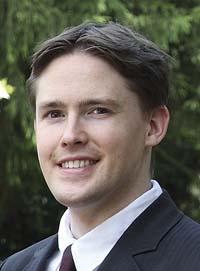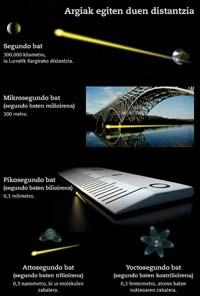Second divided into a quad

The yoctosecond is the least interval of time that exists today, that is, some quadrilion of a second. It is easy to define a smaller interval, at least mathematically, but in practice that is the frontier of human beings.
It is nothing, the time it takes for light to pass through the nucleus of an atom side by side. And being so short, that time goes beyond our intuition. Astronomer Carl Sagan said: "Our ability to appropriate the world, which we call common sense, depends on certain scales of size, speed and time that correspond to human beings. We are able to become aware of things that have a length of between ten and several kilometers of a millimeter, that have a duration of less than a second to a full life, etc. ".
However, if there are more scales than the corresponding ones, shorter and longer. At first, man has explored. Over time, he has begun to use what was discovered in this exploration and has finally needed to control those times.
Without clock
The exploration has already reached the territory of the yoctosecond, but its use is in the area of longer time intervals one million times, in attoseconds. The research of the yoctosecond is very early (the yocto prefix itself was approved in 1991 in the International System of Units only twenty years ago), while lasers that function at the attosecond scale exist in physics laboratories.
"There is currently no yoctosecond measurement technique. But this situation is common," says physicist Jörg Evers, head of the team investigating the yoctosecond at the Max Planck Institute's Nuclear Physics Center. "For example, they have had to invent new detection techniques to measure the attosecond pulses emitted by the last lasers. We now seek ideas to develop techniques that measure yoctosecond pulses. The main reason to think that these pulses only last a few yoctoseconds is that they are emitted by a quark-gluon plasma that only lasts a few yoctoseconds."

But the argument gives a wheel of witches. How do you know how long this plasma lasts if it cannot be measured? Theoretical physicists have the answer.
Evers plasma consists of quarkes and gluons, particles that are not free in nature, such as plasma. In fact, quarks are components of protons and neutrons bound together by the action of gluons. Therefore, these particles are the basic components of the nucleus of atoms. When they detach from the nucleus they do not remain whole, but they disintegrate into other particles. The duration of this event is calculated by theoretical physicists. With great precision, that is why Evers knows that the life of the quark-gluon plasma is of several yoctoseconds.
An energy problem
Working at that time is very limited, so far it has only theoretical interest. For example, a laser based on a quark-gluon plasma cannot be done.
"The world's largest heavy ion accelerator is needed right now to create this plasma," says Evers. "There are theoretical proposals to generate laser pulses on the scale of zeptoseconds (a thousand times longer than yoctoseconds). But in practice, for the moment, it has not been achieved. These proposals are based on weak nuclear force and our theory goes one step further: it is based on strong nuclear force."
And if possible, what would it do? It is difficult to imagine. Today, lasers with shorter pulses, which emit attosecond pulses, have been used to investigate electron movements in real time. And a yoctosecond scale laser could serve to follow something a million times faster.
However, in addition to being technically difficult, physicists should face another problem. "Because of Heissenberg's uncertainty principle, working on yoctoseconds means very little precision in energy measurement," says DIPC physicist Pedro Miguel Etxenike.

For example, the energy of a beam of light is measured with great precision for a second. It's like measuring "average" energy in a second. But if we measure its energy in a certain microsecond, the error is greater. Much greater. And when analyzing a much shorter time, the error will be even greater. Knowing the energy of lightning in a certain yoctosecond is almost impossible. "Doing the calculations, the error is 662 MeV," says Etxenike. That is, it cannot be known if that ray of light contains a small energy of the radio frequencies or a gigantic energy of the cosmic rays.
It is not a technical difficulty, but a law of nature. This means that it is a universal principle. This principle makes the information that can be received from a system very limited. An example is the pair of time and energy (there are other couples). Once the analyses of one end, the perception of the other is lost. Therefore, working on the yoctosecond scale does not necessarily involve advantages.
However, physicists do not close the door to work with shorter times. "Nobody knows where the limit is," says Evers. But it is very difficult to move on that path. "In our proposal, the time it takes for light to pass through the quark-gluon plasma is a limit to creating pulses. Therefore, I think in the near future there will be no sources emitting shorter pulses."
However, there is a reason to try to further reduce the limits of the intervals; the zeptosecond (10 -21 s), the attosecond (10 -18”) and the femtosecond (10 -15”) provoked the same reflection as the yoctosecond. And currently the zeptosecond laser is in project, the most attosecond is in laboratories and in the process of marketing the most femtosecond. The latter, moreover, has already been used to analyze the atomic mechanism of combustion and to create more efficient engines. So why can't the same thing happen with the yoctosecond in the future? Time will tell.





